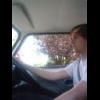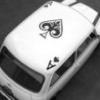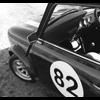I got flashed in 1998 driving through Cheltenham, the road markings had all been re-done, it was a dark winters evening and tipping it down and due to the level of water on the road and refraction of street lights, you could only see the previous white lines which were still raised up but had been painted over to hide them... The road widened and seemed to split into 2 lanes, the left hand lane was on a red which i just thought was for turning left... I suddenly realised that my current course was taking me to the right of a keep left sign and the whole road layout was now 10M left of where it had been previously when i drove through a month or 2 before.
I yanked the wheel to pull me into the correct lane (which was on red) and it was clear that i would not be able to stop in time... and being 18 i decided that the handbrake would definatley stop me!!

It did.. but not before i could pass the line by a considerable distance. Luckily the police would have recieved a nice side on view of a brand new(at the time) Cooper sport pack in Volcano.
I'm afraid it's just one to put down to experience and from now on make sure that you are driving at the correct speed for the road and conditions at the time.
We all seem to think that the highway code is something to overcome to pass our driving tests.. which it is, but it also contains all of the rules and laws applicable as a road user. Here's a bit i just cut and pasted......
You MUST NOT
drive dangerously
drive without due care and attention
drive without reasonable consideration for other road users
[Law RTA 1988 sects 2 & 3 as amended by RTA 1991]
145
You MUST NOT drive on or over a pavement, footpath or bridleway except to gain lawful access to property, or in the case of an emergency.
[Laws HA 1835 sect 72 & RTA 1988 sect 34]
146
Adapt your driving to the appropriate type and condition of road you are on. In particular do not treat speed limits as a target. It is often not appropriate or safe to drive at the maximum speed limit, take the road and traffic conditions into account. Be prepared for unexpected or difficult situations, for example, the road being blocked beyond a blind bend. Be prepared to adjust your speed as a precaution where there are junctions, be prepared for road users emerging
in side roads and country lanes look out for unmarked junctions where nobody has priority
be prepared to stop at traffic control systems, road works, pedestrian crossings or traffic lights as necessary try to anticipate what pedestrians and cyclists might do. If pedestrians, particularly children, are looking the other way, they may step out into the road without seeing you
147
Be considerate. Be careful of and considerate towards all types of road users, especially those requiring extra care (see Rule 204). You should
try to be understanding if other road users cause problems; they may be inexperienced or not know the area well
be patient; remember that anyone can make a mistake
not allow yourself to become agitated or involved if someone is behaving badly on the road. This will only make the situation worse. Pull over, calm down and, when you feel relaxed, continue your journey
slow down and hold back if a road user pulls out into your path at a junction. Allow them to get clear. Do not over-react by driving too close behind to intimidate them
not throw anything out of a vehicle, for example, cigarette ends, cans, paper or carrier bags. This can endanger other road users, particularly motorcyclists and cyclists
204-225: Road users requiring extra care
148
Safe driving and riding needs concentration.
Avoid distractions when driving or riding such as
loud music (this may mask other sounds)
trying to read maps
inserting a cassette or CD or tuning a radio
arguing with your passengers or other road users
eating and drinking
smoking
You MUST NOT smoke in public transport vehicles or in vehicles used for work purposes in certain prescribed circumstances. Separate regulations apply to England, Wales and Scotland.






















